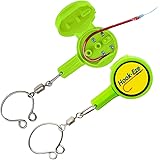If you’re an angler, you know that catching fish is both challenging and rewarding. However, even the most experienced angler struggles to catch fish from time to time. The key to success is learning how to read the water. By understanding how to interpret the features and movements of the water, you can increase your chances of catching more fish. In this article, we’ll be discussing expert advice on reading the water and how it can help you catch more fish.
Understanding Water Features:
 The first step to reading water is understanding the features that you’ll be encountering. Water can be divided into two categories: still water and moving water. Still water refers to ponds, lakes, and other bodies of water that are relatively calm. Moving water includes rivers, streams, and other waterways that have a current. Each of these features presents its own set of challenges and nuances that you’ll need to be aware of.
The first step to reading water is understanding the features that you’ll be encountering. Water can be divided into two categories: still water and moving water. Still water refers to ponds, lakes, and other bodies of water that are relatively calm. Moving water includes rivers, streams, and other waterways that have a current. Each of these features presents its own set of challenges and nuances that you’ll need to be aware of.
Reading Still Water:
When it comes to reading still water, there are several key factors to consider. First, take note of any visible structure like weed beds, submerged logs, or rocks that can provide shelter for fish. Second, understand the surrounding environment, such as the time of day and the weather conditions. These factors can affect where fish might be in the water column. The third factor to consider is the water temperature. If the water temperature is warmer, fish will be more active and likely closer to the surface.
Reading Moving Water:
Moving water is predictably more complex than still water as it is consistently evolving. When fishing in rivers or streams, take note of the flows in the water. Fish congregate around the edges of currents or where the water changes depth. Look for areas with slower currents and eddies before throwing your line. Other factors to consider include the size of the body of water, the weather conditions, and how the current is moving. Understanding these factors is crucial when reading moving water.
Bait and Lure Selection:
Once you have learned to read the water, the next important factor is bait and lure selection. Effective bait and lures can be the difference between a good day of fishing and a frustrating one. Choose bait or lures that match the type of fish you’re targeting, their size, and the conditions of the water you’re fishing. For example, if you’re fishing for trout in a small stream, consider using small spinners and flies designed for that species of fish.
Conclusion:
To sum up, learning how to read water is an essential skill for anglers. By considering the water features, understanding the environment, and selecting the right bait or lures, you increase your chances of catching more fish dramatically. So, next time you’re out on the water, take a moment to observe and analyze the water’s movements to give yourself an advantage. Happy fishing!
In conclusion, by taking the time to learn how to read the water, anglers can greatly increase their chances of success. From understanding the types of water features and how they affect fish and choosing the right bait or lures, every piece of knowledge helps. So next time you’re planning a fishing trip, remember to stop and assess the water before you dive in. With these expert tips, you’ll be well on your way to catching more fish than ever before.


























































